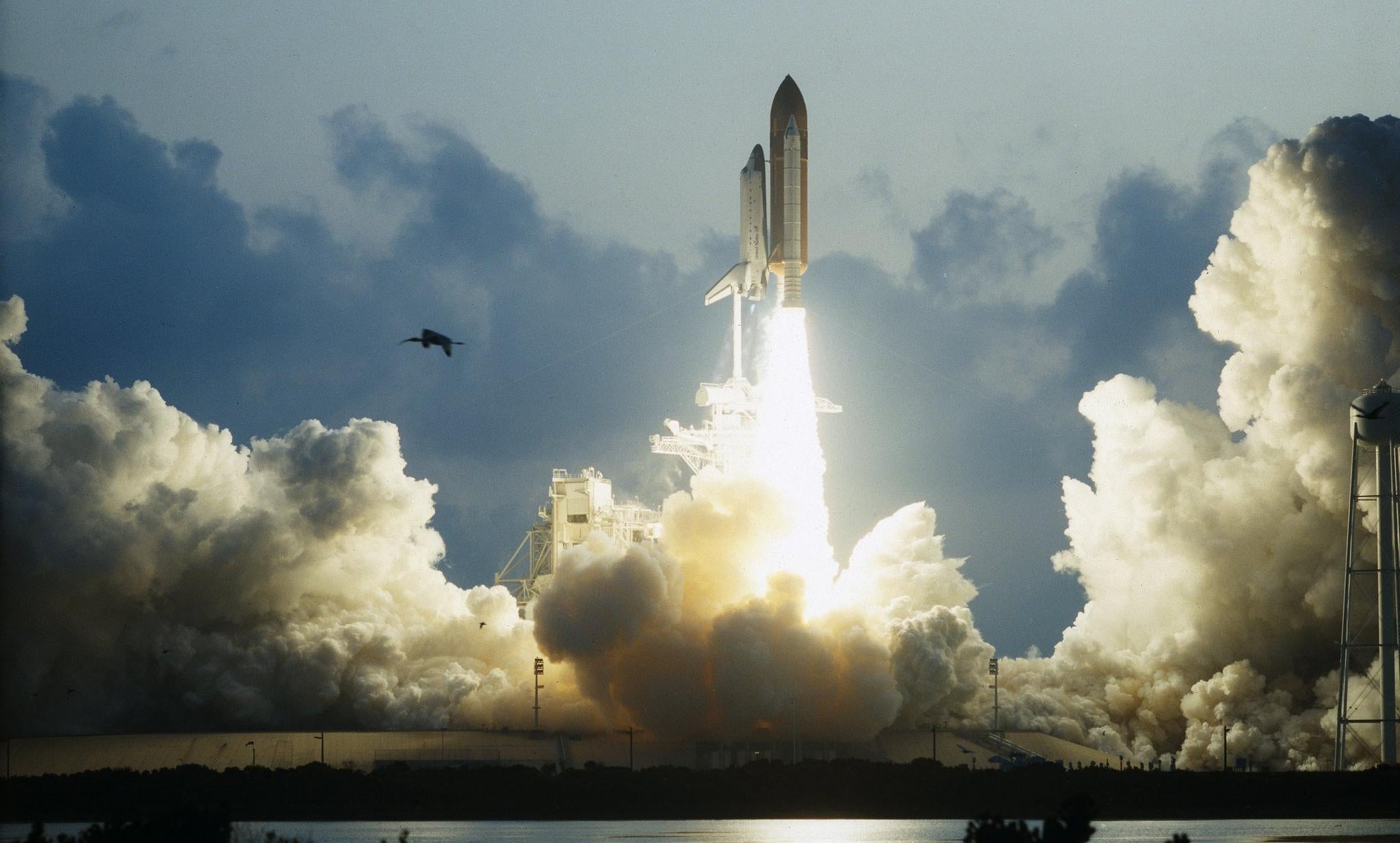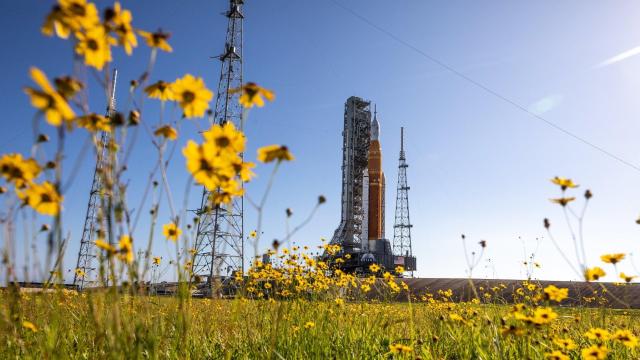NASA’s Space Launch System is powered by a mixture of liquid hydrogen and liquid oxygen. Together, these elements provide for a compact and extremely powerful rocket propellant, but these same attributes are also what make this fuel a liability.
The second launch attempt of SLS had to be called off on Saturday, September 3, after engineers failed to resolve a hydrogen leak in a quick disconnect — an 8-inch inlet that connects the liquid hydrogen fuel line to the rocket’s core stage. As a result of the setback, SLS probably won’t launch until October at the earliest. The Artemis 1 mission, in which an uncrewed Orion spacecraft will journey to the Moon and back, will have to wait.
Ground teams were able to fix a hydrogen leak during the first failed launch attempt on Monday, August 29, but the launch was eventually called off after a faulty sensor erroneously indicated that an engine hadn’t reached the required ultra-cold temperature. The leak on Saturday proved to be much more difficult to contain, with engineers attempting three fixes, none of which worked. “This was not a manageable leak,” Mike Sarafin, Artemis mission manager, told reporters after the scrub.
NASA is still evaluating its next steps, but the rocket must return to the Vehicle Assembly Building to undergo a mandated safety check related to its flight termination system. The rocket may require some hardware fixes on account of an inadvertent command that briefly raised the pressure within the system. The unintended over-pressurization may have contributed to the leaky seal, and it’s something engineers are currently evaluating as a possibility.
Inheriting the hydrogen problem
Hydrogen leaks are nothing new for NASA. Scrubs of Space Shuttle launches happened with upsetting regularity and were often the result of hydrogen leaks. One of the more infamous episodes was “the summer of hydrogen,” when ground teams spent more than six months trying to locate an elusive hydrogen leak that grounded the Shuttle fleet in 1990. SLS is heavily modelled after the Space Shuttle, including the use of liquid hydrogen propellant, so hydrogen-related scrubs could certainly have been predicted. But SLS is what it is, and NASA has little choice but to manage this limitation of its mega Moon rocket.
Jordan Bimm, a space historian at the University of Chicago, says NASA continues to use liquid hydrogen for political rather than technical reasons.
“Since the creation of NASA in 1958, the agency has used contractors located around the U.S. as a way to maintain broad political support and funding for space exploration in Congress,” Bimm told me. “The first system to use liquid hydrogen was the Centaur rocket developed in the 1950s and 1960s. In 2010, the U.S. Congress, in their authorization act funding NASA, mandated that the Agency use existing technologies from the Shuttle in their next-generation launch system.” To which he added: “This was a political decision meant to maintain contractor jobs in key political districts and from that funding and support in Congress for NASA.”

This development meant that the RS-25 engine from the retiring Space Shuttle, along with its reliance on a liquid hydrogen/liquid oxygen mixture, would have to be carried over to SLS. In total, NASA managed to collect 16 engines from the retired Shuttles, of which four are currently affixed to the SLS rocket standing on the launch pad at Kennedy Space Centre in Florida.
This situation, said Bimm, is a reminder of the catchphrase from the 1983 film The Right Stuff: “No bucks, no Buck Rogers.” NASA, he said, “must often prioritise shoring-up political support from Congress to maintain its exploration program.” The ongoing use of RS-25 engines “is another example of how something as mundane as fuel choice can be political and how often the most straightforward and desirable solutions are not politically viable for a large national agency created in the Cold War era of ‘Big Science’,” said Bimm.
Instead of opting for propellants like methane or kerosene, NASA chose to use a mixture of liquid hydrogen and liquid oxygen to power its heavy-lift rocket. By comparison, SpaceX’s upcoming Starship uses liquid methane, with liquid oxygen as the oxidizer. “With their sights set on Mars, SpaceX selected liquid methane in the hopes of being able to extract this element [when] on Mars as a form of cost-saving resource utilization,” Bimm explained. The U.S. space agency, perpetually cash-strapped and having to please politicians, was working under a different set of principles when designing SLS.
“Based on current information and analysis, the [proposed SLS design] represents the lowest near-term costs, soonest available, and the least overall risk path to the development of the next, domestic heavy lift launch vehicle,” wrote NASA in a 2011 preliminary project report. “Selecting this SLS architecture would mean that a new liquid engine in the near term would not need to be developed, thus shortening the time to first flight as well as likely minimising the overall…cost of the SLS.”
The irony is that SLS, which was supposed to fly in 2017, has yet to launch, and its total development costs, including the Orion crew capsule, have now exceeded $US50 ($69) billion. That excludes the estimated $US4.1 ($6) billion cost pegged for each launch of SLS. And by inheriting Space Shuttle components, NASA has also inherited the hydrogen problem.
A beneficial but pesky molecule
Hydrogen is extremely useful as a rocket fuel. It’s readily available, clean, lightweight, and, when combined with liquid oxygen, burns with extreme intensity. “In combination with an oxidizer such as liquid oxygen, liquid hydrogen yields the highest specific impulse, or efficiency in relation to the amount of propellant consumed, of any known rocket propellant,” according to NASA. When chilled to -253 degrees Celsius, hydrogen can be crammed into a rocket, offering a tremendous amount of fuel for the buck. “The advantages of liquid hydrogen as a fuel is its efficiency at storing the energy you want to release to propel the rocket, as well as its low weight, which is always a consideration in spaceflight,” said Bimm.

NASA’s Apollo-era Saturn rocket second stage used liquid hydrogen, as did the Shuttle’s three main engines. Hydrogen is commonly used for second stages (Europe’s heavy-lift Ariane 5 rocket is a good example), and as the liquid fuel needed for manoeuvring spacecraft in orbit. Rockets that currently use liquid hydrogen include Atlas’s Centaur and Boeing’s Delta III and IV, while Blue Origin’s BE-3 and BE-7 engines also rely on hydrogen.
“The disadvantages of hydrogen are that it is very difficult to move around and control due to the small molecular size of hydrogen which leads to leaks and the need to keep it in a liquid state which requires cooling to extremely low temperatures,” said Bimm. What’s more, hydrogen is highly volatile when in a liquid state, and it can burn in large quantities. As the lightest known element, it’s also very leaky. NASA explains the many challenges of using liquid hydrogen as fuel:
To keep it from evaporating or boiling off, rockets fuelled with liquid hydrogen must be carefully insulated from all sources of heat, such as rocket engine exhaust and air friction during flight through the atmosphere. Once the vehicle reaches space, it must be protected from the radiant heat of the Sun. When liquid hydrogen absorbs heat, it expands rapidly; thus, venting is necessary to prevent the tank from exploding. Metals exposed to the extreme cold of liquid hydrogen become brittle. Moreover, liquid hydrogen can leak through minute pores in welded seams.
Despite these challenges, NASA opted for liquid hydrogen when designing SLS, and now it’s paying the price.
New rocket, same old problems
When tanking SLS, the sudden influx of cryogenic hydrogen causes significant changes to the rocket’s physical structure. The 40-metre-tall hydrogen tank shrinks about 152 mm in length and about 25.4 mm in diametre when filled with the ultra-cold liquid, according to NASA. Components attached to the tank, such as ducts, vent lines, and brackets, must compensate for this sudden contraction. To achieve this, NASA uses connectors with accordion-like bellows, slotted joints, telescoping sections, and ball joint hinges.
But hydrogen — the smallest molecule in the universe — often finds its way through even the tiniest of openings. The fuel lines are particularly problematic, as they cannot be hard-bolted to the rocket. As their name suggests, the quick disconnects, while providing a tight seal, are designed to break free from the rocket during launch. This seal must prevent leakage under high pressures and ultra-cold temperatures, but it also needs to let go as the rocket takes flight. On Saturday, a leak in the vicinity of the quick disconnect reached concentrations well beyond the 4% constraint, exceeding NASA’s flammability limits. Unable to resolve the leak, NASA called the scrub.
That NASA has yet to fully fuel the first and second stages and get deep into the countdown is a genuine cause for concern. The space agency has dealt with hydrogen leaks before, so hopefully its engineers will once again devise a solution to move the project forward.
Still, it’s a frustrating start to the Artemis era. NASA needs SLS as it seeks a permanent and sustainable return to the lunar environment, and as it eyes a future human mission to Mars. NASA is going to have to make SLS work, and it might have to do so one aggravating scrub at a time.
